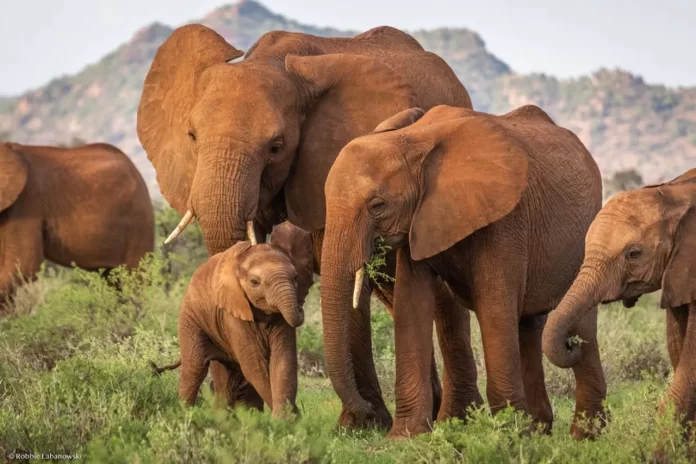Drought across much of Africa is becoming longer and more severe due to climate change This damages elephant habitats and denies them the water they need. African elephants need hundreds of litres of water each day to survive.
Sydney: African elephant numbers have dropped from about 26 million in the 1800s to 415,000 today. While this is largely due to European colonisation, poaching and habitat loss, these majestic animals now face another grave challenge, a report in the Deccan Chronicle,says
Drought across much of Africa is becoming longer and more severe due to climate change This damages elephant habitats and denies them the water they need. African elephants need hundreds of litres of water each day to survive.
The African savanna elephant is listed as endangered. If the situation doesn’t change, Africa may lose one of its most iconic animal species.
A tragic plight
Elephants are not just important for their ecological, cultural and economic value. They are also a keystone species that is, they help hold ecosystems together. This means their decline has far-reaching consequences.
Many African ecosystems pivot around the lives of elephants. Elephant feeding habits, such as pushing over trees and peeling off bark, can turn woody vegetation into grasslands. This makes room for smaller species to move in. Their digging for water in dry riverbeds creates water holes other animals can use. And as they migrate, elephants help spread seeds in their dung.
Under climate change, long, intense droughts across southern and eastern Africa are escalating. Some have lasted more than 20 years.The conditions have left many elephants desperate for water.
Research as far back as 2003 shows elephants in Zimbabwe were dying during drought. And in 2016, when a drying El Nino weather pattern hit southern Africa, there were reports of more elephant deaths, prompting a local conservation group to drill bore holes to provide relief.
Drought can also reduce the availability of food, causing elephants to starve. It can also mean young elephants die or don’t develop properly, because their parched mothers produce less milk.
A unique physiology
So, why do elephants struggle in drought and heat?
When elephants experience high internal temperatures, it can disrupt the function of cells, tissues and organs such as the liver and cause them to become sick and die.
Humans and other animals also suffer heat stress. But elephants are particularly vulnerable because they can’t sweat it off.
Heat accumulates through an elephants’ natural metabolism and physical activity, as well as being absorbed from the environment.
But it does not always effectively dissipate. Elephants’ thick skin slows heat loss and their lack of sweat glands exacerbates this.
What’s more, elephants are the largest of all land mammals, weighing up to eight tonnes. They also have a large body volume which generates heat but a relatively small surface area (their skin) from which to lose this heat.
Water is essential for elephants to cope with heat. They swim and spray their skin with mud and water; the subsequent evaporation mimicks sweating and cools them down. And elephants cool themselves internally by drinking several hundred litres of water a day.
Let elephants roam free
Creating artificial water sources is a common management intervention when elephants need water. This includes the use of pipes, bores and pumps.
But this measure can be problematic. Sometimes, the water is sourced from supplies needed by local people. And large numbers of elephants congregating around water can permanently damage the local environment and reduce food availability for other animals.
Historically, elephants migrated to water during drought. But the introduction of fenced areas in the landscape has disrupted this movement.
Fences were constructed to mark out colonial land ownership, separate people from large animals and deter poachers.
But as climate change worsens in Africa, elephants and other wildlife must be able to move freely between connected habitats.
Community management projects, such as in Northern Kgalagadi in Botswana, show how local expertise drawn from millennia of experience and knowledge can guide wildlife management.
Protecting a keystone species
Ensuring African elephants survive drought will increasingly require new conservation strategies, including community-based management. Without this, already dwindling elephant populations will continue to decline.
This would be bad news for the health and stability of natural ecosystems in Africa and a blow to Africa’s people.
*****************************************************************
Readers
These are extraordinary times. All of us have to rely on high-impact, trustworthy journalism. And this is especially true of the Indian Diaspora. Members of the Indian community overseas cannot be fed with inaccurate news.
Pravasi Samwad is a venture that has no shareholders. It is the result of an impassioned initiative of a handful of Indian journalists spread around the world. We have taken the small step forward with the pledge to provide news with accuracy, free from political and commercial influence. Our aim is to keep you, our readers, informed about developments at ‘home’ and across the world that affect you.
Please help us to keep our journalism independent and free.
In these difficult times, to run a news website requires finances. While every contribution, big or small, will makes a difference, we request our readers to put us in touch with advertisers worldwide. It will be a great help.
For more information: pravasisamwad00@gmail.com



